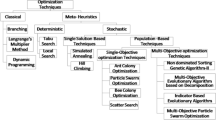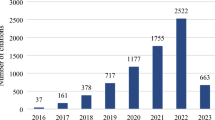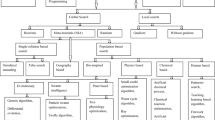Abstract
This paper proposes a technique for solving the multiobjective environmental/economic dispatch problem using the weighted sum and \(\varepsilon \)-constraint strategies, which transform the problem into a set of single-objective problems. In the first strategy, the objective function is a weighted sum of the environmental and economic objective functions. The second strategy considers one of the objective functions: in this case, the environmental function, as a problem constraint, bounded above by a constant. A specific predictor-corrector primal-dual interior point method which uses the modified log barrier is proposed for solving the set of single-objective problems generated by such strategies. The purpose of the modified barrier approach is to solve the problem with relaxation of its original feasible region, enabling the method to be initialized with unfeasible points. The tests involving the proposed solution technique indicate i) the efficiency of the proposed method with respect to the initialization with unfeasible points, and ii) its ability to find a set of efficient solutions for the multiobjective environmental/economic dispatch problem.


Similar content being viewed by others
References
Abido, M. A. (2003). Environmental/economic power dispatch using multiobjective evolutionary algorithms. IEEE Transactions on Power Systems, 18(4), 1529–1537.
Abido, M. A. (2006). Multiobjective evolutionary algorithms for electric power dispatch problem. IEEE Transactions on Power Systems, 10(3), 315–329.
Arantes, M. B., Oliveira, G. T. S., & Saramago, S. F. P. (2006). Evolução diferencial aplicada à solução de alguns problemas de engenharia de produção. FAMAT em Revista, (06).
Balbo, A. R., Souza, M. A. S., Baptista, E. C., & Nepomuceno, L. (2012). A predictor corrector-primal-dual interior points method for solving economic dispatch problems: A post optimization analysis. Mathematical Problems in Engineering, 2012, 1–26.
Bayón, L., Grau, J. M., Ruiz, M. M., & Suárez, P. M. (2012). The exact solution of the environmental/economic dispatch problem. IEEE Transactions on Power Systems, 27(2), 723–731.
Coelho, L. S., & Mariani, V. C. (2006). Otimização de despacho econômico com ponto de válvula usando estratégia evolutiva e método Quase–Newton. Learning Nonlinear Models—Revista da Sociedade Brasileira de Redes Neurais (SBRN), 04(01), 1–12.
El-Keib, A. A., Ma, H., & Hart, J. L. (1994). Environmentally constrained economic dispatch using the Lagrangian relaxation method. IEEE Transactions on Power Systems, 9(4).
El-Hawary, M. E., El-Hawary, F., & GAN, M. (1992). NO\(_{\rm x }\) emission performance models in electric power system. In Canadian Conference on Electrical and Computer Engineering (Vol. 2) Paper MA 8.11.1.
Fiacco, A. V., & McCormick, G. P. (1990). Nonlinear programming: Sequential unconstrained minimization techniques. Classics in applied mathematics (Vol. 4). Philadelphia, PA: SIAM.
Frisch, K. R. (1955). The logarithmic potential method of convex programming. Oslo, Norway: University Institute of Economics (manuscript).
Gent, M. R., & Lamont, J. W. (1971). Miminum-emission dispatch. IEEE Transactions on Power Apparatus and Systems, PAS–90(6), 2650–2660.
Granville, S. (1994). Optimal reactive dispatch through interior point methods. IEEE Transactions on Power Systems, 9, 135–146.
Haimes, Y.Y., Lasdon, L., Wismer, & Wisme D. A. (1971). On a bicriterion formulation of the problems of integrated system identification and system optimization. IEEE Transactions on Systems, Man, and Cybernetics SMC-1(3), 296-297.
Hu, Y.-L., & Wee, W. G. (1994). A hierarchical system for economic dispatch with environmental constraints. IEEE Transactions on Power Systems, 9(2), 1076–1082.
Jubril, A. M., Komolafe, O. A., & Alawode, K. O. (2013). Solving multi-objective economic dispatch problem via semidefinite programming. IEEE Transactions on Power Systems, 28(3), 2056–2064.
Kojima, M., Mizuno, S., & Yoshise, A. (1989). A primal dual—interior point method for linear programming. In N. Megiddo (Ed.), Progress in mathematical programming: Interior-point and related methods (pp. 29–48). New York: Springer.
Mehrotra, S., & Sun, J. (1992). An algorithm for convex quadratic programming that requires 0 (n\(^{3.5}\) L) arithmetic operations. Mathematics of Operations Research, 15, 342–363.
Miettinen, K. (1999). Nonlinear multiobjective optimization. Boston: Kluwer.
Monteiro, R. C., Adler, I., & Resende, M. C. (1990). A polynomial-time primal-dual affine scaling algorithm for linear and convex quadratic programming and its power series extension. Mathematics of Operations Research, 15, 191–214.
Polyak, R. A. (1992). Modified barrier functions. Mathematical Programming, 54(2), 177–222.
Ramanathan, R. (1994). Emission constrained economic dispatch. IEEE Transactions on Power Systems, 9(4), 1994–2000.
Sousa, V. A., Baptista, E. C., & Costa, G. R. M. (2012). Optimal reactive power flow via the modified barrier Lagrangian function approach. Electric Power Systems Research, 84(1), 159–164.
Sousa, V. A., Baptista, E. C., & Costa, G. R. M. (2009). Loss minimization by the predictor-corrector modified barrier approach. Electric Power Systems Research, 79(5), 803–808.
Souza, M. A. S. (2010). Investigação e aplicação de métodos primal—dual de pontos interiores em problemas de despacho econômico e ambiental. Dissertação de Mestrado, Universidade Estadual Paulista—UNESP, Bauru-SP.
Steinberg, M. J. C., & Smith, T. H. (1943). Economic loading of power plants and electric systems. New York: McGraw-Hill.
Ferial, J. H. T., & EI-Hawary, M. E. (1994). A summary of environmental/economic dispatch algorithms. IEEE Transactions on Power Systems, 9(3), 1508–1516.
Wong, K. P., Fan, B., Chang, C. S., & Liew, A. C. (1995). Multi-objective generation dispatch using bi-criterion global optimisation. IEEE Transactions on Power Systems, 10(4), 1813–1819.
Wright, S. J. (1997). Primal-dual interior point methods. SIAM Journal, 289-304.
Wu, Y. C., Debs, A. S., & Marsten, R. E. (1994). A direct nonlinear predictor-corrector primal-dual interior point algorithm for optimal power flows. IEEE Transactions on Power Systems, 9(2), 876–883.
Zhang A., Zhang, J., Shang, J., & Qin, J. (2009). Security and Economic Dispatch of Power. IEEE PES General Meeting, pp. 1-6.
Author information
Authors and Affiliations
Corresponding author
Rights and permissions
About this article
Cite this article
de Lorena Stanzani, A., Balbo, A.R., Nepomuceno, L. et al. Solving the Multiobjective Environmental/Economic Dispatch Problem using Weighted Sum and \(\upvarepsilon \)-Constraint Strategies and a Predictor-Corrector Primal-Dual Interior Point Method. J Control Autom Electr Syst 25, 503–515 (2014). https://doi.org/10.1007/s40313-014-0122-x
Received:
Revised:
Accepted:
Published:
Issue Date:
DOI: https://doi.org/10.1007/s40313-014-0122-x




